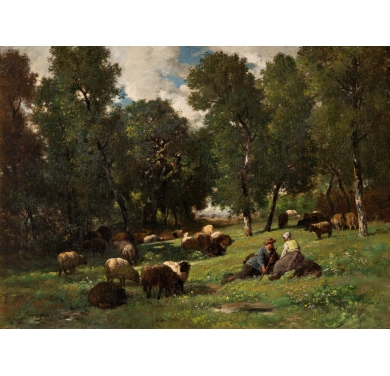Charles Jacque (1813-1894) - The rest of the shepherds
Oil on canvas signed lower left
Dimensions : H. 48 x W. 65 cm (with frame : H. 74 x W. 92 cm)
Charles Jacque is a great French naturalist painter. He was one of the founders of the Barbizon school in which he was recognized as the specialist of sheep and farmyard subjects. His work is widely exhibited in major museums in France and abroad.
At an early age, he was apprenticed to a map engraver, from whom he kept the precision of the line and the mastery of drawing. He made his first etchings after Rembrandt's works. After a stint in the army, he left France for England to create the illustrations for a work by Shakespeare. His most important works were done in the Barbizon countryside and in the Fontainebleau region. Charles Jacque's output is quite large, and there are many small formats on the market today, often of farmyards, as well as some somewhat repetitive and quickly executed pastoral scenes. The important works were, for many, preempted by museums at the beginning of the 20th century.
In 1889, Charles JACQUE was awarded the Grand Prix at the Salon, and in the same year he was awarded the Gold Medal at the Exposition Universelle.
? Our painting is a rare work by Charles Jacque and of very high quality. We will note the softness of the representation of the characters, which are relatively rare in the paintings of this artist. The painter opted here for a larger size than those he usually uses in order to produce a work whose composition is particularly rich: presence of a large number of sheep, some located in the foreground while others are further away, lush vegetation with multiple shades of green, admirable perspective effect and, in the upper part, a blue sky crossed by clear clouds that contributes to the bright character of the scene represented. In this strong and realistic work, Charles Jacque is very close to another great master of naturalism, Jean-François Millet.
This work was done on a canvas that is still the original one. It has not suffered any notable damage and the restorations are minimal. The network of cracks is quite apparent, due to the absence of lining and refixing, but the pictorial material still has a perfect adhesion to the support. The superb frame "à cannaux" is original, in very good condition and perfectly restored with gold leaf.
Museums : Paris, Louvre Museum, Amsterdam, Angers, Béziers, Chambéry, The Hague, Reims, La Rochelle ...






